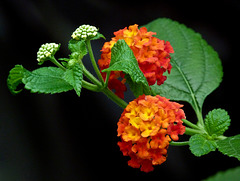Anne Elliott's photos with the keyword: Verbenaceae
Changing colours of Lantana
| 28 Apr 2014 |
|
|
|
This flower looked a whole lot better in a smaller size - I think it's a little overpowering when cropped! Photographed at the Calgary Zoo on 25 September 2012, and posted because today is supposed to be cloudy and rainy.
"Lantana's aromatic flower clusters (called umbels) are a mix of red, orange, yellow, or blue and white florets. Other colors exist as new varieties are being selected. The flowers typically change color as they mature, resulting in inflorescences that are two- or three-colored." From Wikipedia.
en.wikipedia.org/wiki/Lantana
We certainly had a mix of weather the last two days. Saturday, it was snowing with poor visibility. A few of us had gathered to go on a birding drive south of the city, but weren't sure whether to cancel the trip. We drove to the edge of the city to check out a huge pond, but it was decided that the visibility was just not going to be good enough, so the trip was postponed. Two of us did drive some of the backroads just south of the city and the snow did stop for a while, but the light was not good. I really appreciated the drive, though, as we went on a few roads that I don't drive, but now will feel confident to do so. Thanks so much, Terry! We had a few nice sightings, including a Moose, a Snow Goose (possibly a Ross's Goose) that I didn't see, and a distant flock of about 60 Mountain Bluebirds which was a real treat. The Yellow-headed Blackbirds are now back, joining the Red-winged Blackbirds that I believe arrived first.
Yesterday, Sunday (27 April 2014), I went with friends to Frank Lake for the day. It started off extremely foggy with a touch of hoarfrost. Perhaps not the ideal weather for seeing birds, but the fog did eventually clear and the sun came out. It turned out to be a beautiful day and most enjoyable. We saw 53 bird species - all, except for two owl nests, were extremely distant, so any photos I took are so far away. Have to admit that I was fascinated by the hoar frost and (melting) ice crystals, so I spent some time taking photos these while my friends checked out the lake for distant sightings of birds. Caught a distant glimpse of two White-faced Ibis, and several Snow Geese flew over. Greg Wagner from High River came to check out the lake while we were there, and he drew our attention to a Clarke's Grebe, which was a great sighting. Thanks, Greg! Three of the owl nests had young ones that could be seen, but through a tangle of branches, so useless for photos. The one nest had very young owlets, still with white feathers. Thanks, Tony, for leading this trip to one of my very favourite areas! Your trips are always very successful and so enjoyable.
Tropical Lantana
| 03 May 2012 |
|
Taken in the ENMAX Conservatory at the Calgary Zoo on April 27th.
"Lantana is a genus of about 150 species of perennial flowering plants in the verbena family, Verbenaceae. They are native to tropical regions of the Americas and Africa but exist as an introduced species in numerous areas, especially in the Australian-Pacific region. The genus includes both herbaceous plants and shrubs growing to 0.5–2 m (1.6–6.6 ft) tall. Their common names are shrub verbenas or lantanas.
Lantana's aromatic flower clusters (called umbels) are a mix of red, orange, yellow, or blue and white florets. Other colors exist as new varieties are being selected. The flowers typically change color as they mature, resulting in inflorescences that are two- or three-colored." From Wikipedia.
en.wikipedia.org/wiki/Lantana
Large-bract Vervain / Verbena bracteata
| 19 Jul 2011 |
|
I don't remember ever seeing this wildflower before - anyway, it's the first photo of it on my photostream. The tiny flowers were such a pretty colour. This was found on a hike on the Small Whaleback, an area of wonderful, rolling hills way south of the city, on July 10th. The Small Whaleback (and yes, there is a larger Whaleback nearby, lol) is just off Highway 22, immediately north of the Oldman River.
"Verbena bracteata is a species of verbena known by the common names bigbract verbena, prostrate vervain, and carpet vervain. It is native to North America where it is widespread, occurring throughout the continent except for northern Canada and southern Mexico. It occurs in many types of habitat, especially disturbed areas, where it grows as a common weed. This annual or biennial herb produces several hairy, spreading stems up to 30 centimeters long forming a low mat on the ground. The hairy leaves are toothed or lobed. The inflorescence is a spike of flowers which is dense with long, pointed, leaflike bracts each up to 8 millimeters long. Each small tubular flower is about half a centimeter wide and white to pale purple in color." From Wikipedia.
Clerodendrum thomsoniae
| 21 Nov 2008 |
|
I'm not sure if I ever did find out the name of this Tropical plant, but I always find it fascinating with its pink and red parts. Quite elegant - was growing in the Conservatory at the Calgary Zoo, which has now been pulled down, ready for the start of constructing a brand new building for us all to enjoy.
Jump to top
RSS feed- Anne Elliott's latest photos with "Verbenaceae" - Photos
- ipernity © 2007-2025
- Help & Contact
|
Club news
|
About ipernity
|
History |
ipernity Club & Prices |
Guide of good conduct
Donate | Group guidelines | Privacy policy | Terms of use | Statutes | In memoria -
Facebook
Twitter




